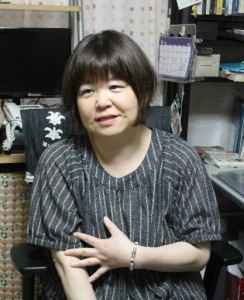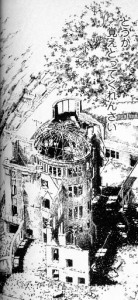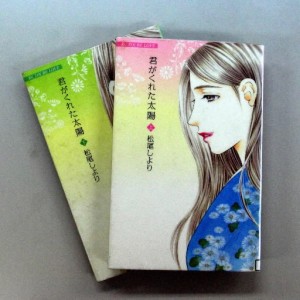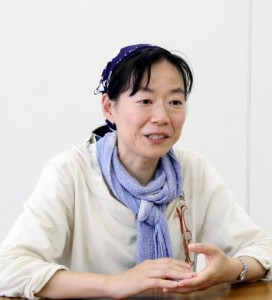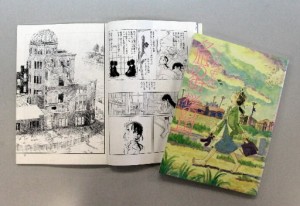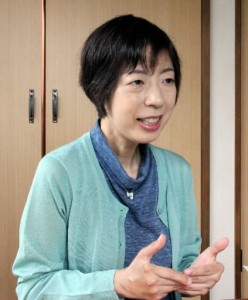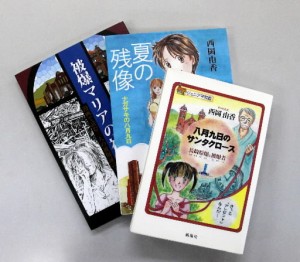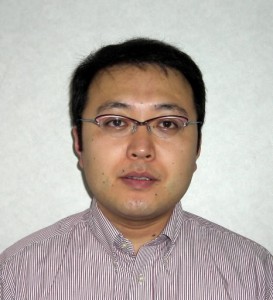Peace Seeds: Teens in Hiroshima Sow Seeds of Peace (Part 33)
Jun. 16, 2016
Part 33: A-bomb manga of 21st century engage readers with familiar aspects of life
Handing down the memories of the A-bomb survivors is by no means an easy task. Many survivors say, “You can’t really understand because you didn’t experience it yourself.” Still, we mustn’t give up even if can’t fully comprehend the experience.
The junior writers interviewed three people who have been seeking to communicate the feelings of the survivors through comic books, or manga, a form accessible to younger generations. These manga artists in their 40s and 50s, of our parents’ generation, have no direct experiences of the war, the atomic bombings, or the hardships that were endured in the postwar period. Nevertheless, they listened to survivors’ accounts, consulted reference material, and wrote their stories.
In their manga, the main characters live through the war and the postwar period. They fall in love and have families they adore, though they may sometimes quarrel. Some of these stories touch the present day, too, enabling us to more easily empathize with the characters. We recommend that you read these manga.
Shiyori Matsuo, 51, expresses anger over the loss of people’s ordinary lives
Shiyori Matsuo, 51, a resident of Tokyo, shows how a family’s ordinary life was destroyed by the atomic bomb. She described the idea running through her work in this way: “People do their utmost to ensure the safety of their families, and the fact that war between nations destroys their lives is unforgivable.”
Ms. Matsuo was born in Nagoya and raised in Osaka. While growing up, she saw many TV programs and photos that conveyed the war and the atomic bombing. Even before becoming a manga artist, she had longed to write a story about the war. In 1998, eight years after her debut, her manga Sora to Umi no Aida (Between the Sky and the Sea) was serialized. Then, with the blessing of her editors, she created a story about the war called The Sun You Gave Me. Her work puts importance on families so that people of the present can relate to her stories.
Ms. Matsuo spent a year preparing for her work on The Sun You Gave Me, her story about the atomic bombing. She bought books and picture postcards from those days and listened to the experiences of the A-bomb survivors. At times, she said, she felt the pressure of conveying their feelings. To her, this story was the hardest one to complete.
She is now hoping to make a new manga that features survivors going on with their lives through the postwar days in Hiroshima while suffering from discrimination and worries about their health. Ms. Matsuo believes that a story like this, about Hiroshima’s revival, could encourage the people of Fukushima. (Takeshi Iwata, 17)
The Sun You Gave Me, Part 1 and Part 2 (2008)
Fumiko and Kanji meet at Fukuya Department Store, which opened in 1929. They fall in love, get married, and begin their life together in Kawaya-cho (now Hondori, a busy shopping area), where Kanji runs a fruit and vegetable shop. Though the war casts a dark shadow over life in Japan, they try to move forward with their lives. But then the atomic bomb is dropped on the city.
Fumiyo Kono, 47, faces up to the terrible tragedy of the Hiroshima A-bombing
Fumiyo Kono, 47, a resident of Kyoto, decided to write a story about the atomic bombing when her editor suggested that she create a manga about Hiroshima. At the time there were not many new manga stories about the atomic bombing being published. Until then, she had avoided this theme because she felt that the bombing was too cruel to consider as a subject. She had even fainted during a visit to the Hiroshima Peace Memorial Museum. But with this suggestion, she thought, “It’s now time to face this reality,” and decided to write the story. The story became popular through word of mouth and the Internet, and it was eventually turned into a film.
Town of Evening Calm, Country of Cherry Blossoms is about the aftereffects of exposure to radiation and discrimination against A-bomb survivors in the postwar period. Ms. Kono hopes that readers will feel that the war and the atomic bombing are not something remote from their lives and that the main character is like a friend.
She also wrote In This Corner of the World, which is set in Kure and Hiroshima during the war. But, at the moment, she has no plans to write another story about the atomic bombing. “My manga stories are fiction. I did research to write them, which anyone can do. There are many people who want to read such stories, but not many people who want to write them. I think more writers should take on these stories.”
She added, “Even if you’ve never experienced war, you have to think seriously about peace, no matter when and where you live, and communicate your thoughts to others in some way.” She also said that she hopes teenagers like us will have a rich imagination and do our best to put ourselves in other people’s shoes. (Miyu Okada, 15, Yoshiko Hirata, 14, and, Akane Sato, 13)
Town of Evening Calm, Country of Cherry Blossoms (Published in 2004 by Futabasha)
The story consists of two parts: “Town of Evening Calm” and “Country of Cherry Blossoms.” “Town of Evening Calm” is set in Hiroshima ten years after the atomic bombing. It is the story of Minami, the main character, who continues to suffer from her experience of the atomic bombing. “Country of Cherry Blossoms” is set in modern-day Tokyo. The central characters are Asahi, Minami’s younger brother; Nanami, her niece; and Nagio, her nephew. Nanami and Nagio are second-generation survivors. The story depicts the influence of the atomic bombing through Nagio’s love.
Yuka Nishioka, 51, decides to put survivors’ accounts into manga stories after inner conflict
“A-bomb survivors still have a flame in their hearts. When I listen to their experiences, my heart also goes through the atomic bombing. I want to tell this to people,” said Yuka Nishioka, 51, a resident of Nagasaki.
While traveling around the world on a Peace Boat voyage in 1999, Ms. Nishioka became aware of how Nagasaki is known throughout the world. She then thought she might be able to depict the atomic bombing of Nagasaki through manga, which she liked. She wondered, though, if it would be all right for her to take on a project like this, since she isn’t an A-bomb survivor. But she made up her mind when a survivor told her, “Do your best to convey what we experienced, even if it’s just one ten-thousandth of it.”
Initially, she wrote a story in which junior high and high school girls meet A-bomb survivors and listen to their experiences, as she thought she could not accurately portray what it was like back then. Later, at the request of A-bomb survivors and her editors, she began to render the survivors’ experiences into manga, too.
The words of one man, a survivor who read Atomic Bombed Maria’s Prayer, still linger in her mind: “A-bomb survivors have a deeper look in their eyes.” She said, “I still don’t have a full understanding of what happened. I’ll spend the rest of my life trying to create better manga.”
Ms. Nishioka believes that she can do a better job of conveying the horrors of the atomic bombing by depicting the survivors’ whole lives, which include their A-bomb experiences. She hopes to create more manga while the A-bomb survivors are still alive and can share the details of their experiences. (Kohei Furohashi, 17)
Afterimage of Summer, August 9 in Nagasaki (2008)
Kana, a high school student living in Tokyo, visits her grandmother, who is an A-bomb survivor and lives in Nagasaki. She also visits the United States and South Korea, where she learns about the negative legacy of the atomic bombing.
Santa Clause of August 9, Nagasaki Atomic Bombing and Hibakusha (2010)
This story is made up of three parts. Part 1, “Nagasaki Atomic Bombing and Hibakusha,” gives the history of Nagasaki and information on exposure to radiation from the atomic bomb. In Part 2, “Santa Clause of August 9,” Mayu, a junior high school student, moves from Tokyo to Nagasaki and learns about the atomic bombing. The epilogue is titled “Promise for Tomorrow.”
Atomic Bombed Maria’s Prayer, Reading Accounts of Three A-bomb Survivors in Manga (2015)
This book depicts the lives of three survivors of the atomic bombing of Nagasaki.
Kazuma Yoshimura, Professor at Kyoto Seika University: Female manga artists offer fresh perspectives on A-bomb manga
Kazuma Yoshimura, 44, a professor in the faculty of manga at Kyoto Seika University, told us, “Many new manga stories about the atomic bombings have come out since the year 2000.” According to Professor Yoshimura, because those who were born in the late 1960s and beyond have read Barefoot Gen, a manga story about the atomic bombing of Hiroshima, while growing up, some have gone on to write their own stories on this theme so that the memories of the atomic bombings and the war won’t be forgotten.
It was Fumiyo Kono, she said, who first brought a fresh perspective to A-bomb manga. Ms. Kono and other female manga artists have made girls and women their protagonists and depicted their lives from the viewpoint of ordinary people. Professor Yoshimura explained that these artists, because they have no personal experience of the war, are able to see these events in a new light and consider how they can make their stories engaging to a wide circle of readers. Previously, male artists created human dramas that featured male characters, such as kamikaze pilots, who part from their loved ones in the years before Japan’s defeat in the war.
Manga stories on the war and the atomic bombings, made by female artists, are now being published almost every year. They continue to add new perspectives on what life was like back then. (Nako Yoshimoto, 17)
Junior writers’ impressions
I seldom read manga, but I’ve found that these manga stories make it easier for us to understand things that are difficult to convey with only words. I’d like to read a lot of manga stories after I’m done studying for entrance examinations. (Takeshi Iwata)
Unlike manga that are created purely for entertainment, the writers of these stories must exercise their ingenuity because they don’t want readers to skim through the main character’s words. In most manga, the main character is on the right side of the panel and his or her words appear on the left. But in Town of Evening Calm, Country of Cherry Blossoms, Minami is often on the left side and her words appear on the right. I haven’t had much opportunity to read manga, but I’ve become interested in them and I want to read more. (Nako Yoshimoto)
My assignment for this article took me to Nagasaki for the first time. Manga artist Yuka Nishioka showed us around the city, and we went to Nagasaki Peace Park and the Atomic Bomb Museum. I learned about Nagasaki first-hand, though this might only be a small part of Nagasaki’s identity. Next time I hope to visit the city with my family and see other parts of the city. (Kohei Furohashi)
Before, I just thought of Nagasaki as a tourist destination. But my trip there to gather information gave me a new perspective on this city. Nagasaki experienced an atomic bombing, just like Hiroshima. I’m now interested in reading manga stories about the atomic bombings. (Miyu Okada)
This was the first time for me to gather information. When we interviewed Shiyori Matsuo, I took photos for the article. I had to hold a half-crouching position so I could aim at Ms. Matsuo’s eye level. My legs started hurting. I have to make my legs stronger. I was nervous when we were interviewing the manga artists, but Ms. Kono and Ms. Matsuo were both so friendly that I had a lot of fun. (Akane Sato)
Why do they depict war in their manga stories? The manga artists we interviewed have a strong sense of mission. We should take this subject seriously, too, and learn about war through manga. (Yukiho Saito)
What is Peace Seeds?
Peace Seeds are the seeds of smiles which can be spread around the world by thinking about peace and the preciousness of life from various viewpoints. To fill this world with flowering smiles, 39 junior writers, from the first year of junior high school to the third year of high school, choose themes, gather information, and write articles.
(Originally published on June 16, 2016)
Handing down the memories of the A-bomb survivors is by no means an easy task. Many survivors say, “You can’t really understand because you didn’t experience it yourself.” Still, we mustn’t give up even if can’t fully comprehend the experience.
The junior writers interviewed three people who have been seeking to communicate the feelings of the survivors through comic books, or manga, a form accessible to younger generations. These manga artists in their 40s and 50s, of our parents’ generation, have no direct experiences of the war, the atomic bombings, or the hardships that were endured in the postwar period. Nevertheless, they listened to survivors’ accounts, consulted reference material, and wrote their stories.
In their manga, the main characters live through the war and the postwar period. They fall in love and have families they adore, though they may sometimes quarrel. Some of these stories touch the present day, too, enabling us to more easily empathize with the characters. We recommend that you read these manga.
Shiyori Matsuo, 51, expresses anger over the loss of people’s ordinary lives
Shiyori Matsuo, 51, a resident of Tokyo, shows how a family’s ordinary life was destroyed by the atomic bomb. She described the idea running through her work in this way: “People do their utmost to ensure the safety of their families, and the fact that war between nations destroys their lives is unforgivable.”
Ms. Matsuo was born in Nagoya and raised in Osaka. While growing up, she saw many TV programs and photos that conveyed the war and the atomic bombing. Even before becoming a manga artist, she had longed to write a story about the war. In 1998, eight years after her debut, her manga Sora to Umi no Aida (Between the Sky and the Sea) was serialized. Then, with the blessing of her editors, she created a story about the war called The Sun You Gave Me. Her work puts importance on families so that people of the present can relate to her stories.
Ms. Matsuo spent a year preparing for her work on The Sun You Gave Me, her story about the atomic bombing. She bought books and picture postcards from those days and listened to the experiences of the A-bomb survivors. At times, she said, she felt the pressure of conveying their feelings. To her, this story was the hardest one to complete.
She is now hoping to make a new manga that features survivors going on with their lives through the postwar days in Hiroshima while suffering from discrimination and worries about their health. Ms. Matsuo believes that a story like this, about Hiroshima’s revival, could encourage the people of Fukushima. (Takeshi Iwata, 17)
The Sun You Gave Me, Part 1 and Part 2 (2008)
Fumiko and Kanji meet at Fukuya Department Store, which opened in 1929. They fall in love, get married, and begin their life together in Kawaya-cho (now Hondori, a busy shopping area), where Kanji runs a fruit and vegetable shop. Though the war casts a dark shadow over life in Japan, they try to move forward with their lives. But then the atomic bomb is dropped on the city.
Fumiyo Kono, 47, faces up to the terrible tragedy of the Hiroshima A-bombing
Fumiyo Kono, 47, a resident of Kyoto, decided to write a story about the atomic bombing when her editor suggested that she create a manga about Hiroshima. At the time there were not many new manga stories about the atomic bombing being published. Until then, she had avoided this theme because she felt that the bombing was too cruel to consider as a subject. She had even fainted during a visit to the Hiroshima Peace Memorial Museum. But with this suggestion, she thought, “It’s now time to face this reality,” and decided to write the story. The story became popular through word of mouth and the Internet, and it was eventually turned into a film.
Town of Evening Calm, Country of Cherry Blossoms is about the aftereffects of exposure to radiation and discrimination against A-bomb survivors in the postwar period. Ms. Kono hopes that readers will feel that the war and the atomic bombing are not something remote from their lives and that the main character is like a friend.
She also wrote In This Corner of the World, which is set in Kure and Hiroshima during the war. But, at the moment, she has no plans to write another story about the atomic bombing. “My manga stories are fiction. I did research to write them, which anyone can do. There are many people who want to read such stories, but not many people who want to write them. I think more writers should take on these stories.”
She added, “Even if you’ve never experienced war, you have to think seriously about peace, no matter when and where you live, and communicate your thoughts to others in some way.” She also said that she hopes teenagers like us will have a rich imagination and do our best to put ourselves in other people’s shoes. (Miyu Okada, 15, Yoshiko Hirata, 14, and, Akane Sato, 13)
Town of Evening Calm, Country of Cherry Blossoms (Published in 2004 by Futabasha)
The story consists of two parts: “Town of Evening Calm” and “Country of Cherry Blossoms.” “Town of Evening Calm” is set in Hiroshima ten years after the atomic bombing. It is the story of Minami, the main character, who continues to suffer from her experience of the atomic bombing. “Country of Cherry Blossoms” is set in modern-day Tokyo. The central characters are Asahi, Minami’s younger brother; Nanami, her niece; and Nagio, her nephew. Nanami and Nagio are second-generation survivors. The story depicts the influence of the atomic bombing through Nagio’s love.
Yuka Nishioka, 51, decides to put survivors’ accounts into manga stories after inner conflict
“A-bomb survivors still have a flame in their hearts. When I listen to their experiences, my heart also goes through the atomic bombing. I want to tell this to people,” said Yuka Nishioka, 51, a resident of Nagasaki.
While traveling around the world on a Peace Boat voyage in 1999, Ms. Nishioka became aware of how Nagasaki is known throughout the world. She then thought she might be able to depict the atomic bombing of Nagasaki through manga, which she liked. She wondered, though, if it would be all right for her to take on a project like this, since she isn’t an A-bomb survivor. But she made up her mind when a survivor told her, “Do your best to convey what we experienced, even if it’s just one ten-thousandth of it.”
Initially, she wrote a story in which junior high and high school girls meet A-bomb survivors and listen to their experiences, as she thought she could not accurately portray what it was like back then. Later, at the request of A-bomb survivors and her editors, she began to render the survivors’ experiences into manga, too.
The words of one man, a survivor who read Atomic Bombed Maria’s Prayer, still linger in her mind: “A-bomb survivors have a deeper look in their eyes.” She said, “I still don’t have a full understanding of what happened. I’ll spend the rest of my life trying to create better manga.”
Ms. Nishioka believes that she can do a better job of conveying the horrors of the atomic bombing by depicting the survivors’ whole lives, which include their A-bomb experiences. She hopes to create more manga while the A-bomb survivors are still alive and can share the details of their experiences. (Kohei Furohashi, 17)
Afterimage of Summer, August 9 in Nagasaki (2008)
Kana, a high school student living in Tokyo, visits her grandmother, who is an A-bomb survivor and lives in Nagasaki. She also visits the United States and South Korea, where she learns about the negative legacy of the atomic bombing.
Santa Clause of August 9, Nagasaki Atomic Bombing and Hibakusha (2010)
This story is made up of three parts. Part 1, “Nagasaki Atomic Bombing and Hibakusha,” gives the history of Nagasaki and information on exposure to radiation from the atomic bomb. In Part 2, “Santa Clause of August 9,” Mayu, a junior high school student, moves from Tokyo to Nagasaki and learns about the atomic bombing. The epilogue is titled “Promise for Tomorrow.”
Atomic Bombed Maria’s Prayer, Reading Accounts of Three A-bomb Survivors in Manga (2015)
This book depicts the lives of three survivors of the atomic bombing of Nagasaki.
Kazuma Yoshimura, Professor at Kyoto Seika University: Female manga artists offer fresh perspectives on A-bomb manga
Kazuma Yoshimura, 44, a professor in the faculty of manga at Kyoto Seika University, told us, “Many new manga stories about the atomic bombings have come out since the year 2000.” According to Professor Yoshimura, because those who were born in the late 1960s and beyond have read Barefoot Gen, a manga story about the atomic bombing of Hiroshima, while growing up, some have gone on to write their own stories on this theme so that the memories of the atomic bombings and the war won’t be forgotten.
It was Fumiyo Kono, she said, who first brought a fresh perspective to A-bomb manga. Ms. Kono and other female manga artists have made girls and women their protagonists and depicted their lives from the viewpoint of ordinary people. Professor Yoshimura explained that these artists, because they have no personal experience of the war, are able to see these events in a new light and consider how they can make their stories engaging to a wide circle of readers. Previously, male artists created human dramas that featured male characters, such as kamikaze pilots, who part from their loved ones in the years before Japan’s defeat in the war.
Manga stories on the war and the atomic bombings, made by female artists, are now being published almost every year. They continue to add new perspectives on what life was like back then. (Nako Yoshimoto, 17)
Junior writers’ impressions
I seldom read manga, but I’ve found that these manga stories make it easier for us to understand things that are difficult to convey with only words. I’d like to read a lot of manga stories after I’m done studying for entrance examinations. (Takeshi Iwata)
Unlike manga that are created purely for entertainment, the writers of these stories must exercise their ingenuity because they don’t want readers to skim through the main character’s words. In most manga, the main character is on the right side of the panel and his or her words appear on the left. But in Town of Evening Calm, Country of Cherry Blossoms, Minami is often on the left side and her words appear on the right. I haven’t had much opportunity to read manga, but I’ve become interested in them and I want to read more. (Nako Yoshimoto)
My assignment for this article took me to Nagasaki for the first time. Manga artist Yuka Nishioka showed us around the city, and we went to Nagasaki Peace Park and the Atomic Bomb Museum. I learned about Nagasaki first-hand, though this might only be a small part of Nagasaki’s identity. Next time I hope to visit the city with my family and see other parts of the city. (Kohei Furohashi)
Before, I just thought of Nagasaki as a tourist destination. But my trip there to gather information gave me a new perspective on this city. Nagasaki experienced an atomic bombing, just like Hiroshima. I’m now interested in reading manga stories about the atomic bombings. (Miyu Okada)
This was the first time for me to gather information. When we interviewed Shiyori Matsuo, I took photos for the article. I had to hold a half-crouching position so I could aim at Ms. Matsuo’s eye level. My legs started hurting. I have to make my legs stronger. I was nervous when we were interviewing the manga artists, but Ms. Kono and Ms. Matsuo were both so friendly that I had a lot of fun. (Akane Sato)
Why do they depict war in their manga stories? The manga artists we interviewed have a strong sense of mission. We should take this subject seriously, too, and learn about war through manga. (Yukiho Saito)
What is Peace Seeds?
Peace Seeds are the seeds of smiles which can be spread around the world by thinking about peace and the preciousness of life from various viewpoints. To fill this world with flowering smiles, 39 junior writers, from the first year of junior high school to the third year of high school, choose themes, gather information, and write articles.
(Originally published on June 16, 2016)

